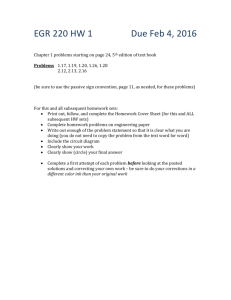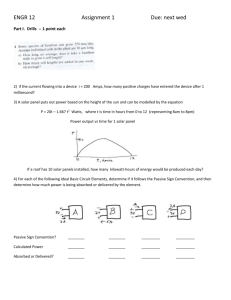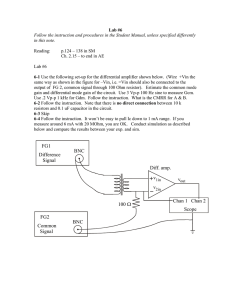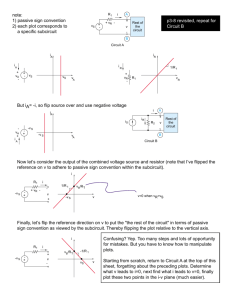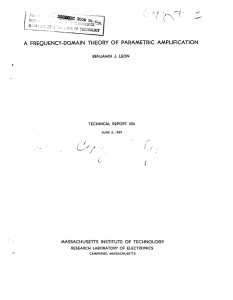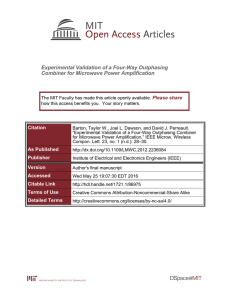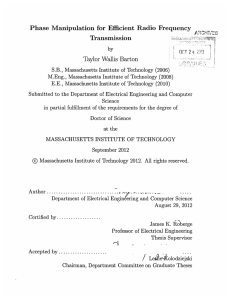XII. CIRCUIT THEORY Prof. S. J. Mason
advertisement
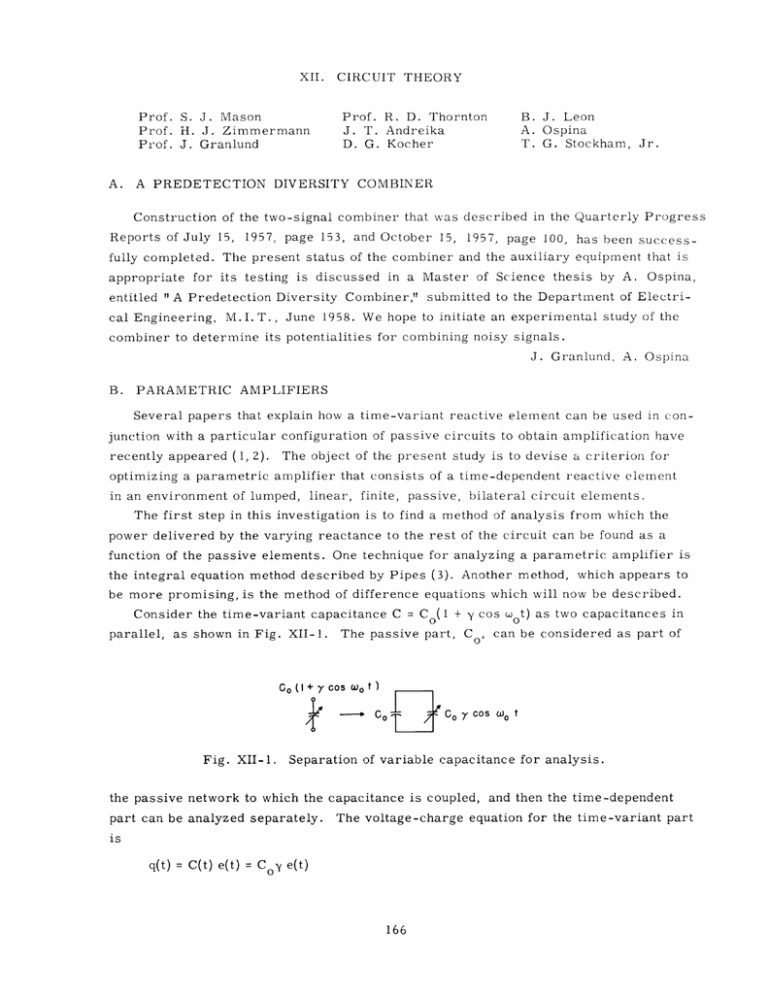
XII. Prof. S. J. Mason Prof. H. J. Zimmermann Prof. J. Granlund A. CIRCUIT THEORY Prof. R. D. Thornton J. T. Andreika D. G. Kocher B. J. Leon A. Ospina T. G. Stockham, Jr. A PREDETECTION DIVERSITY COMBINER Construction of the two-signal combiner that was described in the Quarterly Progress Reports of July 15, 1957, page 153, and October 15, 1957, page 100, has been successfully completed. The present status of the combiner and the auxiliary equipment that is appropriate for its testing is discussed in a Master of Science thesis by A. Ospina, entitled "A Predetection Diversity Combiner," submitted to the Department of Electrical Engineering, M.I.T., June 1958. We hope to initiate an experimental study of the combiner to determine its potentialities for combining noisy signals. J. Granlund, A. Ospina B. PARAMETRIC AMPLIFIERS Several papers that explain how a time-variant reactive element can be used in con- junction with a particular configuration of passive circuits to obtain amplification have recently appeared (1, 2). The object of the present study is to devise a criterion for optimizing a parametric amplifier that consists of a time-dependent reactive element in an environment of lumped, linear, finite, passive, bilateral circuit elements. The first step in this investigation is to find a method of analysis from which the power delivered by the varying reactance to the rest of the circuit can be found as a function of the passive elements. One technique for analyzing a parametric amplifier is the integral equation method described by Pipes (3). Another method, which appears to be more promising, is the method of difference equations which will now be described. Consider the time-variant capacitance C = Co(l + y cos parallel, as shown in Fig. XII-1. 0ot) as two capacitances in The passive part, C o , can be considered as part of Co (1+ y cos w0 t ) CoCo Fig. XII-1. y cos wo t Separation of variable capacitance for analysis. the passive network to which the capacitance is coupled, and then the time-dependent part can be analyzed separately. The voltage-charge equation for the time-variant part is q(t) = C(t) e(t) = C 0 e(t) 166 (XII. CIRCUIT THEORY) which can be transformed into the frequency domain as C y Q(s) = 2 [E(s + jw0 ) + E(s - jw )] Then the frequency-domain current-voltage relation for the capacitance is I(s) Coy 2 s [E(s + jwo) + E(s - jwo)] By using Norton' s theorem, we can reduce any parametric amplifier consisting of a single time-variant capacitance, normal time-invariant passive elements and sources to the circuit of Fig. XII-2. In this figure the passive part of the time-dependent capaci- + I(s) I C(t) Fig. XII-2. E(s) Basic parametric amplifier. tance is included in Y(s). If we write Kirchhoff' s current law for the one-node circuit, we obtain the linear difference equation I(s) = Y(s) E(s) + Cy 2 s[E(s + j o) 0 + E(s - jw0 ) ] (1) Since Y(s) is a positive real admittance function, it is a rational function of s. Con- sequently, the homogeneous part of Eq. 1 - that is, the equation with the forcing function I(s) set equal to zero - is a linear second-order difference equation with rational coefficients. (If C(t) were not a single sinusoid, but consisted of n harmonics, the difference equation would be of 2n order.) Milne-Thomson (4) describes two methods for solving such equations. By both methods the canonical form of solution is a factorial series. In order to obtain the particular solution to a difference equation such as Eq. 1, we " sum" the forcing function. (" Summing" is to difference equations as integrating is to differential equations.) The forcing function that is of interest in microwave parametric amplifiers is the steady-state sinusoid in the time domain or the impulse (8-function) in the frequency domain. The 6-function should prove particularly easy to sum by the methods described by Milne-Thomson. For a step or a sinusoidal transient, I(s) becomes a rational function of frequency. Milne-Thomson gives a method for summing such func- tions. By studying the exact solution to Eq. 1 - subject only to the restriction that Y(s) be positive real - we expect to find out how the admittance should be selected for 167 (XII. CIRCUIT THEORY) maximizing the power output and bandwidth of a parametric amplifier. An approximate method of solution to the problem illustrated by Fig. XII-2, which has been published by Bolle (5), I(s) = AS(w - should be mentioned. For the steady-state case, a), E(s) will be a series of 6-functions of the form Ek6[w - (ca + k in which k takes on all integer values from -oo to + oo. )], Equation 1 can then be separated into an infinite series of linear algebraic equations, one for each frequency. Coy A = E Y(jW ) + • 0 a [E 2j O = E k Y(jw a + kwo) 0+ j Cy + E ] (2) (wa + kwo) [Ek- l Each of Eqs. 2 has three unkown voltages. the voltages in terms of any two. + Ek+l] for k 0 0 Therefore we can solve for all of If the admittance is such that the voltages at certain frequencies are known to be vanishingly small, we can solve for the other nonzero voltages. Since this technique for solving the difference equation (Eq. 1) requires the assumption of an admittance function before solving, it is not completely satisfactory for obtaining general conditions for optimizing the admittance. It is, however, a very simple method of analyzing a circuit in which only a few of the voltage terms are nonzero. B. J. Leon References 1. H. Suhl, Phys. Rev. 106, 384 (1957). 2. S. Bloom and K. K. N. Chang, RCA Rev. 18, 578-593 (1957). 3. L. A. Pipes, Four methods of analysis of time variable circuits, Trans. IRE, vol. CT-2, no. 1, pp. 4-12 (1955). 4. L. M. Milne-Thomson, The Calculus of Finite Differences (Macmillan Company, Ltd., London, 1933; Reprint, St. Martin' s Press, New York, 1951). 5. A. P. Bolle, Application of complex symbolism to linear variable networks, Trans. IRE, vol. CT-2, no. 1, pp. 32-35 (1955). 168

